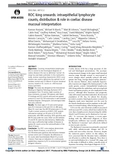Long-term proton pump inhibitors and risk of gastric cancer development after treatment for Helicobacter pylori: a population-based study

Objective Proton pump inhibitors (PPIs) is associated
with worsening of gastric atrophy, particularly in
Helicobacter pylori (HP)-infected subjects. We determined
the association between PPIs use and gastric cancer
(GC) among HP-infected subjects who had received HP
therapy.
Designs This study was based on a territory-wide
health database of Hong Kong. We identified adults who
had received an outpatient prescription of clarithromycin-
based triple therapy between year 2003 and 2012.
Patients who failed this regimen, and those diagnosed to
have GC within 12 months after HP therapy, or gastric
ulcer after therapy were excluded. Prescriptions of PPIs or
histamine-2 receptor antagonists (H2RA) started within
6 months before GC were excluded to avoid protopathic
bias. We evaluated GC risk with PPIs by Cox proportional
hazards model with propensity score adjustment. H2RA
was used as a negative control exposure.
Result Among the 63 397 eligible subjects, 153
(0.24%) developed GC during a median follow-up of 7.6
years. PPIs use was associated with an increased GC risk
(HR 2.44, 95%CI 1.42 to 4.20), while H2RA was not
(HR 0.72, 95%CI 0.48 to 1.07). The risk increased with
duration of PPIs use (HR 5.04, 95% CI 1.23 to 20.61;
6.65, 95% CI 1.62 to 27.26 and 8.34, 95% CI 2.02 to
34.41 for ≥1 year, ≥2 years and ≥3 years, respectively).
The adjusted absolute risk difference for PPIs versus non-
PPIs use was 4.29 excess GC (95%CI 1.25 to 9.54) per
10 000 person-years.
Conclusion Long-term use of PPIs was still associated
with an increased GC risk in subjects even after HP
eradication therapy.

Prebiotic galacto-oligosaccharides mitigate the adverse effects of iron fortification on the gut microbiome: a randomised controlled study in Kenyan infants

Objective Iron-containing micronutrient powders
(MNPs) reduce anaemia in African infants, but the
current high iron dose (12.5mg/day) may decrease
gut Bifidobacteriaceae and Lactobacillaceae, and
increase enteropathogens, diarrhoea and respiratory
tract infections (RTIs). We evaluated the efficacy and
safety of a new MNP formula with prebiotic galacto-
oligosaccharides (GOS) combined with a low dose (5mg/
day) of highly bioavailable iron.
Design In a 4-month, controlled, double-blind trial,
we randomised Kenyan infants aged 6.5–9.5 months
(n=155) to receive daily (1) a MNP without iron (control);
(2) the identical MNP but with 5mg iron (2.5mg as
sodium iron ethylenediaminetetraacetate and 2.5mg as
ferrous fumarate) (Fe group); or (3) the identical MNP as
the Fe group but with 7.5 g GOS (FeGOS group).
Results Anaemia decreased by ≈50% in the Fe and
FeGOS groups (p<0.001). Compared with the control
or FeGOS group, in the Fe group there were (1) lower
abundances of Bifidobacterium and Lactobacillus
and higher abundances of Clostridiales (p<0.01); (2)
higher abundances of virulence and toxin genes (VTGs)
of pathogens (p<0.01); (3) higher plasma intestinal
fatty acid-binding protein (a biomarker of enterocyte
damage) (p<0.05); and (4) a higher incidence of treated
RTIs (p<0.05). In contrast, there were no significant
differences in these variables comparing the control and
FeGOS groups, with the exception that the abundance
of VTGs of all pathogens was significantly lower in the
FeGOS group compared with the control and Fe groups
(p<0.01).
Conclusion A MNP containing a low dose of highly
bioavailable iron reduces anaemia, and the addition of
GOS mitigates most of the adverse effects of iron on the
gut microbiome and morbidity in African infants.
Trial registration number NCT02118402.

10.1136/gutjnl-2017-314205

Objective Gastric carcinoma development is triggered
by Helicobacter pylori. Chronic H. pylori infection leads
to reduced acid secretion, which may allow the growth
of a different gastric bacterial community. This change in
the microbiome may increase aggression to the gastric
mucosa and contribute to malignancy. Our aim was to
evaluate the composition of the gastric microbiota in
chronic gastritis and in gastric carcinoma.
Design The gastric microbiota was retrospectively
investigated in 54 patients with gastric carcinoma and
81 patients with chronic gastritis by 16S rRNA gene
profiling, using next-generation sequencing. Differences
in microbial composition of the two patient groups were
assessed using linear discriminant analysis effect size.
Associations between the most relevant taxa and clinical
diagnosis were validated by real-time quantitative PCR.
Predictive functional profiling of microbial communities
was obtained with PICRUSt.
Results The gastric carcinoma microbiota was
characterised by reduced microbial diversity, by
decreased abundance of Helicobacter and by the
enrichment of other bacterial genera, mostly represented
by intestinal commensals. The combination of these taxa
into a microbial dysbiosis index revealed that dysbiosis
has excellent capacity to discriminate between gastritis
and gastric carcinoma. Analysis of the functional features
of the microbiota was compatible with the presence of a
nitrosating microbial community in carcinoma. The major
observations were confirmed in validation cohorts from
different geographic origins.
Conclusions Detailed analysis of the gastric microbiota
revealed for the first time that patients with gastric
carcinoma exhibit a dysbiotic microbial community
with genotoxic potential, which is distinct from that of
patients with chronic gastritis.

Guidelines on the management of abnormal liver blood tests

These updated guidelines on the management of
abnormal liver blood tests have been commissioned
by the Clinical Services and Standards Committee
(CSSC) of the British Society of Gastroenterology (BSG)
under the auspices of the liver section of the BSG. The
original guidelines, which this document supersedes,
were written in 2000 and have undergone extensive
revision by members of the Guidelines Development
Group (GDG). The GDG comprises representatives from
patient/carer groups (British Liver Trust, Liver4life, PBC
Foundation and PSC Support), elected members of
the BSG liver section (including representatives from
Scotland and Wales), British Association for the Study of
the Liver (BASL), Specialist Advisory Committee in Clinical
Biochemistry/Royal College of Pathology and Association
for Clinical Biochemistry, British Society of Paediatric
Gastroenterology, Hepatology and Nutrition (BSPGHAN),
Public Health England (implementation and screening),
Royal College of General Practice, British Society of
Gastrointestinal and Abdominal Radiologists (BSGAR)
and Society of Acute Medicine. The quality of evidence
and grading of recommendations was appraised using
the AGREE II tool. These guidelines deal specifically with
the management of abnormal liver blood tests in children
and adults in both primary and secondary care under the
following subheadings: (1) What constitutes an abnormal
liver blood test? (2) What constitutes a standard liver
blood test panel? (3) When should liver blood tests be
checked? (4) Does the extent and duration of abnormal
liver blood tests determine subsequent investigation?
(5) Response to abnormal liver blood tests. They are not
designed to deal with the management of the underlying
liver disease.

Critical research gaps and recommendations to inform research prioritisation for more effective prevention and improved outcomes in colorectal cancer

Objective Colorectal cancer (CRC) leads to significant
morbidity/mortality worldwide. Defining critical research
gaps (RG), their prioritisation and resolution, could
improve patient outcomes.
Design RG analysis was conducted by a
multidisciplinary panel of patients, clinicians and
researchers (n=71). Eight working groups (WG)
were constituted: discovery science; risk; prevention;
early diagnosis and screening; pathology; curative
treatment; stage IV disease; and living with
and beyond CRC. A series of discussions led to
development of draft papers by each WG, which were
evaluated by a 20-strong patient panel. A final list of
RGs and research recommendations (RR) was endorsed
by all participants.
Results Fifteen critical RGs are summarised below:
RG1: Lack of realistic models that recapitulate
tumour/tumour micro/macroenvironment; RG2:
Insufficient evidence on precise contributions of
genetic/environmental/lifestyle factors to CRC risk;
RG3: Pressing need for prevention trials; RG4: Lack
of integration of different prevention approaches;
RG5: Lack of optimal strategies for CRC screening;
RG6: Lack of effective triage systems for invasive
investigations; RG7: Imprecise pathological assessment
of CRC; RG8: Lack of qualified personnel in genomics,
data sciences and digital pathology; RG9: Inadequate
assessment/communication of risk, benefit and
uncertainty of treatment choices; RG10: Need for
novel technologies/interventions to improve curative
outcomes; RG11: Lack of approaches that recognise
molecular interplay between metastasising tumours
and their microenvironment; RG12: Lack of reliable
biomarkers to guide stage IV treatment; RG13: Need to
increase understanding of health related quality of life
(HRQOL) and promote residual symptom resolution;
RG14: Lack of coordination of CRC research/funding;
RG15: Lack of effective communication between
relevant stakeholders.
Conclusion Prioritising research activity and funding could
have a significant impact on reducing CRC disease burden
over the next 5 years.

ROC-king onwards: intraepithelial lymphocyte counts, distribution & role in coeliac disease mucosal interpretation

Objectives Counting intraepithelial lymphocytes
(IEL) is central to the histological diagnosis of
coeliac disease (CD), but no definitive ’normal’ IEL
range has ever been published. In this multicentre
study, receiver operating characteristic (ROC) curve
analysis was used to determine the optimal cut-off
between normal and CD (Marsh III lesion) duodenal
mucosa, based on IEL counts on >400 mucosal
biopsy specimens.
Design The study was designed at the International
Meeting on Digestive Pathology, Bucharest 2015.
Investigators from 19 centres, eight countries of
three continents, recruited 198 patients with Marsh
III histology and 203 controls and used one agreed
protocol to count IEL/100 enterocytes in well-oriented
duodenal biopsies. Demographic and serological data
were also collected.
Results The mean ages of CD and control groups
were 45.5 (neonate to 82) and 38.3 (2–88) years.
Mean IEL count was 54±18/100 enterocytes in CD and
13±8 in normal controls (p=0.0001). ROC analysis
indicated an optimal cut-off point of 25 IEL/100
enterocytes, with 99% sensitivity, 92% specificity and
99.5% area under the curve. Other cut-offs between
20 and 40 IEL were less discriminatory. Additionally,
there was a sufficiently high number of biopsies to
explore IEL counts across the subclassification of the
Marsh III lesion.
Conclusion Our ROC curve analyses demonstrate
that for Marsh III lesions, a cut-off of 25
IEL/100 enterocytes optimises discrimination between
normal control and CD biopsies. No differences in
IEL counts were found between Marsh III a, b and
c lesions. There was an indication of a continuously
graded dose–response by IEL to environmental (gluten)
antigenic influence.

Whole grain-rich diet reduces body weight and systemic low-grade inflammation without inducing major changes of the gut microbiome: a randomised cross-over trial

Objective To investigate whether a whole grain diet
alters the gut microbiome and insulin sensitivity, as well
as biomarkers of metabolic health and gut functionality.
Design 60 Danish adults at risk of developing
metabolic syndrome were included in a randomised
cross-over trial with two 8-week dietary intervention
periods comprising whole grain diet and refined grain
diet, separated by a washout period of ≥6 weeks. The
response to the interventions on the gut microbiome
composition and insulin sensitivity as well on measures
of glucose and lipid metabolism, gut functionality,
inflammatory markers, anthropometry and urine
metabolomics were assessed.
Results 50 participants completed both periods with a
whole grain intake of 179±50 g/day and 13±10 g/day
in the whole grain and refined grain period, respectively.
Compliance was confirmed by a difference in plasma
alkylresorcinols (p<0.0001). Compared with refined
grain, whole grain did not significantly alter glucose
homeostasis and did not induce major changes in the
faecal microbiome. Also, breath hydrogen levels, plasma
short-chain fatty acids, intestinal integrity and intestinal
transit time were not affected. The whole grain diet did,
however, compared with the refined grain diet, decrease
body weight (p<0.0001), serum inflammatory markers,
interleukin (IL)-6 (p=0.009) and C-reactive protein
(p=0.003). The reduction in body weight was consistent
with a reduction in energy intake, and IL-6 reduction was
associated with the amount of whole grain consumed, in
particular with intake of rye.
Conclusion Compared with refined grain diet, whole
grain diet did not alter insulin sensitivity and gut
microbiome but reduced body weight and systemic low-
grade inflammation.
Trial registration number NCT 01731366; Results.

{{item.title}}
![]()
{{item.summary}}



